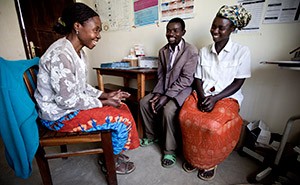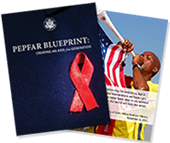- What We Do
- Agriculture and Food Security
- Democracy, Human Rights and Governance
- Economic Growth and Trade
- Education
- Ending Extreme Poverty
- Environment and Global Climate Change
- Gender Equality and Women's Empowerment
- Global Health
- Water and Sanitation
- Working in Crises and Conflict
- U.S. Global Development Lab

At a Glance
Sustainability and Country Ownership
Creating an AIDS-free generation is a shared responsibility between the United States and host country partners. In 2008, the U.S. Congress reauthorized the U.S. President’s Emergency Plan for AIDS Relief (PEPFAR), moving from an emergency response toward a more sustainable and country-owned response to the HIV epidemic. In 2011, Secretary of State Hillary Clinton emphasized “country ownership” as a key step to the sustainability of development initiatives and called upon donors to shift “our approach and our thinking from aid to investment.”
The U.S. Agency for International Development (USAID) has worked with host country partners to accomplish sustainable, country-led and -owned responses for many years, including significant investment in health systems strengthening and local capacity building. USAID has learned from experiences transitioning family planning programs and other health programs from USAID funding to local sources, and the Agency is working to make HIV and AIDS programs more sustainable and help countries lead, manage, implement and ultimately fund these programs.
Definitions
Country Ownership: In its Interagency Paper on Country Ownership, the U.S. Government defines country ownership as being “characterized by government, communities, civil society and private sector [being] able to lead, prioritize, implement and be accountable for a country’s health response.”
Sustainability: USAID’s definition of sustainability is “the capacity of a host country entity to achieve long-term success and stability and to serve its clients and consumers without interruption and without reducing the quality of services after external assistance ends.”
The Roadmap
USAID follows the “Roadmap for Shared Responsibilities,” as outlined in the PEPFAR Blueprint [PDF, 2.8MB]; it specifies PEPFAR’s plan to:
- Partner with countries in a joint move toward country-led and -implemented response.
- Increase support for civil society, with particular concern for the voice and role of people living with HIV, as a partner in the global AIDS response.
- Expand collaboration with multilateral and bilateral partners.
- Increase private sector mobilization toward an AIDS-free generation.
Operationalizing Country Ownership
Country ownership is characterized by government, communities, civil society and the private sector being able to lead, prioritize, implement and be accountable for a country’s health response. USAID’s HIV and AIDS program works across the four dimensions of country ownership, as outlined in the U.S. Government Interagency Paper on Country Ownership [PDF, 784KB].
This is the guiding framework for all activities. The four dimensions are:
Political Ownership and Stewardship
Host country (public and private sectors) is the architect that fully implements and provides oversight of national plan to achieve results. Donors support concept of local ownership.
Institutional and Community Ownership
Host country institutions (inclusive of government, NGOs, civil society, and private sector) constitute the primary vehicles through which health programs are delivered and take responsibility for each program.
Capabilities
Host country has effective workforce, organizations and systems at all levels able to perform activities and carry out responsibilities that achieve priority health outcomes.
Mutual Accountability
Explicit roles and responsibilities are described with appropriate management of performance in place.
Country Ownership in Action

USAID recognizes that countries fall along a continuum of sustainability and country ownership, with some country governments and private sector and civil society organizations leading, implementing, managing and funding all or almost all of their HIV and AIDS response and other countries relying heavily on donors and international partners for funding, implementing and management.
Given this understanding, USAID has worked to build management and operational capacity of host country governments, civil society and the private sector to help move countries along the continuum toward a more country-led HIV response. USAID and other PEPFAR U.S. Government implementing agencies’ field offices have signed 22 Partnership Framework agreements with governments that outline clear and accountable activities and targets for U.S. Government agencies, the partner country government and other stakeholders. These Partnership Frameworks are an important step in engaging local stakeholders in a meaningful manner in the decision-making for PEPFAR planning and funding.
USAID has worked to support (through funding and technical assistance) civil society groups (ranging from groups of people living with HIV to key populations to women’s groups to faith-based organizations) to help them provide more effective HIV services and expand advocacy capacity.
USAID’s Office of Health System Strengthening and USAID’s Office of HIV/AIDS Health System Strengthening Team are focused on improving health systems across the six building blocks of the World Health Organization’s Health Systems Framework. These are critical components of the HIV systems that enable sustainable programming.
USAID Forward and Other Advances in Country Ownership
USAID Forward is facilitating host country engagement and increasing the opportunities for local government, private sector and civil society organizations to be direct implementers of activities. Two focus areas are:
- Building Country Ownership and Capacities
- Strengthening Local Civil Society Organization and Private Sector Capacity
In response to the goal of USAID Forward, project outcomes are expected to be sustainable (continue or evolve under their own momentum or actions, without continued donor intervention). USAID now requires that any new contract or grant with a host country partner, local organization or international organization perform a Sustainability Analysis, which includes the following:
- Identifying how using local partners and government-to-government support could help achieve sustainable goals
- Reviewing the financial implications of project sustainability and conducting a cost analysis
- Identifying future income/revenue
- Assessing the institutional capacity (systems, policies and skills)
Another important component of country ownership is the emphasis on government-to-government funding. A five-step assessment process [PDF, 944KB] is used to determine the suitability of using partner country systems for the implementation of USAID-funded assistance.
Additional Resources

- USAID Technical Issue Brief: Country Ownership [PDF, 1MB]
- USAID FORWARD Implementation & Procurement Reform [PDF, 955KB]
- PEPFAR Country Ownership Page
- PEPFAR Capacity Building and Strengthening Framework [PDF, 1.0MB]
- PEPFAR Blueprint: Creating an AIDS-Free Generation [PDF, 2.8MB]
- Global Health Initiative (GHI) Country Ownership
- Human Resources for Health Toolkit
- U.S. Government Interagency Paper on Country Ownership [PDF,784KB]







Comment
Make a general inquiry or suggest an improvement.